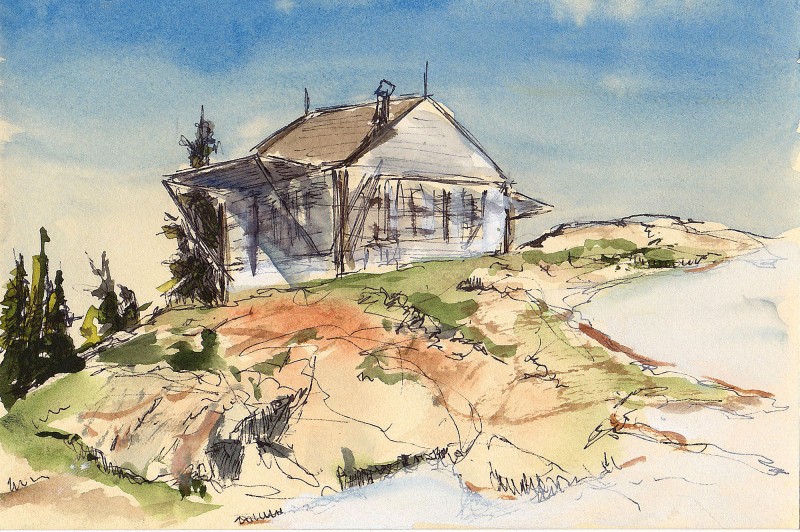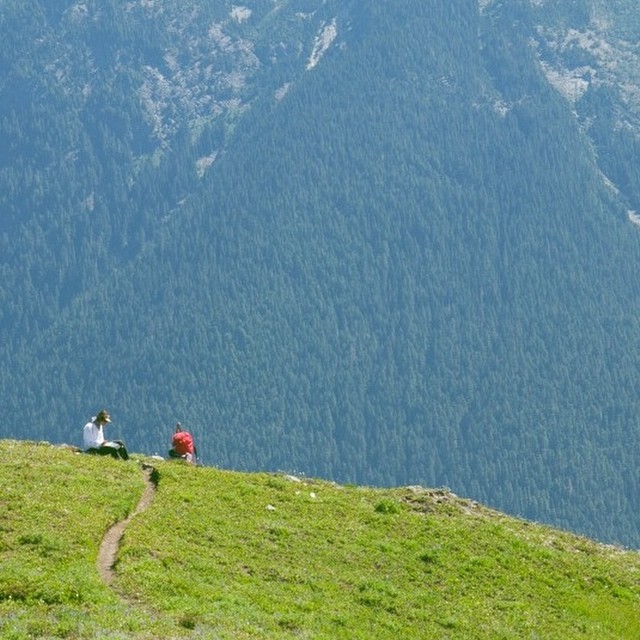Ink and Watercolor
Update! Watch the video of how I created the Mineral Mountain sketch above with ink and watercolor.
I love sketching with ink and watercolor and want to share a few of my favorite tools with you. I typically prefer waterproof pens, as they don’t smudge (like a pencil) and I can apply watercolor washes over them without bleeding. Whenever possible, I use refillable pens to avoid adding waste to landfills. The downside is they’re often more prone to clogging or exploding from changes in altitude, pressure (plane flights, hikes/drives over mountain passes), or neglect. For these reasons, I have a collection of disposable pens I use primarily when traveling or in the backcountry.
My current refillable waterproof pens are the Pentel Brush pen and my 0.35 Rapidograph technical pen. The brush pen has a flexible synthetic tip that can create energetic calligraphic marks, as well as beautiful broken dry brush lines. It also hasn’t leaked on me! I recently carried it around the North Cascades (where I completed the above sketch) without problems. Update: see my video demo of the above painting. The Rapidograph is my hands-down favorite sketching pen. It’s not for everyone, but I love the needle point and scratchy sound it makes on the paper. I’ve used smaller points in the past, but found them even more prone to clogging and damage.

When I don’t want the worry of a refillable pen, I use the Pigma Microns or my Sharpie Pen. The Microns come in a variety of sizes, though they have fragile tips. The Sharpie only comes in one size, but it’s more durable with long lasting ink which is why I include it in the Art Toolkit.


24 Responses to “Ink and Watercolor”
kathryn hannay
thanks very much for the excellent information and lovely sketches. keep sketching and sharing!
Rosita sprohge
Love your work and thanks for sharing your experience.
Bishop
Thank you for this information Maria. So, helpful to be able to learn from others. I thought you last post of panoramas were beautiful but this one of Mineral Mountain is stunning. So much to enjoy….the color, the texture. Would it be possible for you to use an image such as this to share some of your techniques? I look forward to your future posts. All the best to you.
Maria
Thank you, stay tuned!
Charles Kearns
Maria, when you are doing pen & ink with watercolor, do you ink the picture first and then add watercolor or paint the picture then finish with pen & ink. Or both? Just curious as to your process as I really enjoy your mixed medium pictures.
Maria
Hi Charlie, I typically start with ink as the “bones” of the sketch. Adding the watercolor brings it to life! I’ll try to illustrate my technique more in future posts.
Roshini
What kind of paper to do use? Watercolour? I’m trying to find the best paper for mixing these mediums. I was using Strathmore Bristol Smooth which I love but found it did not take heavy washes very well and I like to layer… Thank u! And thanks for sharing your process:)
Maria
Hi Roshini, I typically use a mid-weight paper for my field work. I love Arches Cover cream which has a beautiful soft surface and can take several washes. I will also use lightweight Canson Mi-Tientes paper or a heavier Lenox 100 printmaking paper (250 GSM). I hope that helps!
Jeanne
The picture of your perch atop the Copper Ridge Fire Lookout is rather overwhelming. That is really nature showing off. Huh? So capture it and take it home with you.
Justin Johnson
Hi Maria,
For ink sketching on watercolor paper with waterproof ink, I’ve found a Pilot Penmanship fountain pen is fantastic: cheap, extra fine nib, very smooth flow, and works well with Platinum Carbon Ink, which is about the best pigmented waterproof black ink I’ve found. Jetpens has the pen; Goulet pens has the ink.
One catch is that how quickly it dries waterproof seems to depend on the sizing of the paper. In Moleskine watercolor books it’s totally dry and waterproof pretty much instantly, but other sketchbook papers take a few minutes (like Stillman and Birn) or more (Strathmore). I’ve also found it a great sketching pen alone, with some nib flex, on Moleskine sketchbook paper.
Maria
Thanks for the tip, Justin, I’ll check out that ink! I do have a Rotring F art pen and some older fountains pens, but have only used them with water soluble ink.
Cathy
Hi, love your work! How do you combine gouache and watercolor? I have your travel palette, what paints would you include in the pocket palette (gouache & watercolor)?
thanks
Maria
Hi Cathy, I only carry white gouache (Winsor Newton Zinc White) that I use for my brights on toned paper such as clouds or snow. The white can also be used to tint other watercolors, I think it’s a useful tool. The paints I carry depend on where I’m going, rocky mountains, icy regions, or more forests. Generally I have a basic red, hello, blue, magenta, cyan, and some neutrals (browns). I recommend starting with a simple set. You can check out my color guide for ideas and another good value option is the Daniel Smith Essential 8. Other brands of high quality paint are also great, though I’ve noticed the honey-based versions don’t completely try and can be sticky for travel (Sennelier and M. Graham).
Julianne Winter
I’ve always been one to use Micron pens to ink in my illustrations and it’s nice to see that I’m not the only one! I am really looking forward to trying out some of the other supplies you’ve suggested here. It’s always fun to see what other artists are using! I’ve linked to this post in my latest blog post which talks about using mixed media (specifically ink and watercolor): http://blog.jhwinter.com/watercolor-re-learning-and-perfecting-a-new-medium-part-1/
Maria
Thank you, Julianna! Exploring new supplies is always such fun. Your work is lovely! Maria
Matthew
What would you recommend as an inexpensive pen to use for this purpose in a first grade classroom? They love to watcolor but the marker I use bleeds when the watercolor is applied. Would the fine Sharpie work? They’re pretty inexpensive.
Maria
Hi Mathew, I’d recommend the extra fine Sharpie, http://www.sharpie.com/en-US/extra-fine-point-permanent-marker-sp-00008–1. It’s more durable than the Sharpie pen for holding up to enthusiastic first grade use!
Gary Maricich
Hi, Maria!
Thank you for this forum, your work is superb!!! My dilemma with fountain pens and my vintage rapidigraphs is permanant ink seems to require more maintanance. If I don’t use the pen, I must clean the pen or risk it clogging. Have you found any fountain pen friendly inks (which allow watercolor over) that don’t require so much attention? Thanks in advance!
Gary
Maria
Hi Gary, Goulet Pens has a nice selection of waterproof inks for fountain pens. I think all refillable pens require some TLC, but have used the Platinum Carbon Black ink with some success. Cheers, Maria
Madison
Can I use watercolor over the Sharpie pen, or the other way around? I have a pencil sketch right now and want to watercolor but don’t know what to do, please help!
Maria
Hi Madison, I typically ink my sketches first then do watercolor over. You can certainly do it the other way around, just be sure your paper is completely dry after painting it so the ink doesn’t bleed. You can also just paint over your pencil, it’s up to you to decide what approach you like best! :)
Madyson
Hi Maria, thanks for the tips! Just wondering if the Sharpie pen would still hold up to watercolors on a canvas? Thanks!
Maria
Hi Madyson, I don’t know about Sharpies and canvas! The fine pen I’m using here is slightly different than their extra-fine permanent markers- I find it will not write well on glossy surfaces, unlike the marker. I’d recommend experimenting with some small samples. Cheers, Maria
Noah
Thank you for this really great article. It is concise and to the point, it really is perfect.